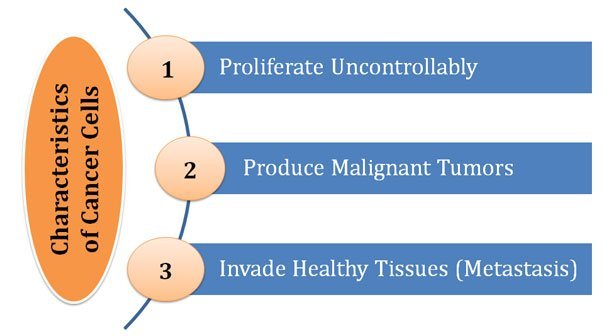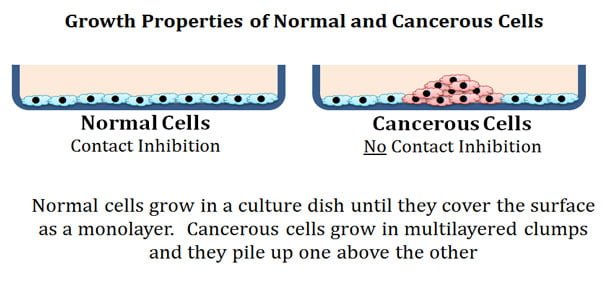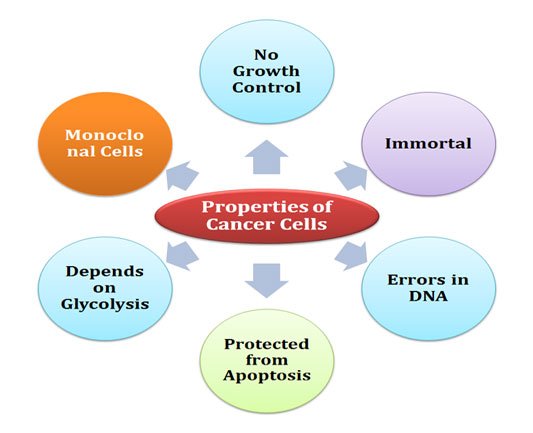What is Cancer?
Ø Cancer is a disease caused by an uncontrolled division of abnormal cells.
Ø Cancer is a genetic disease.
Ø Caused by the alterations in specific genes in the cell.
Ø Cancer can be an inherited disease. However, in most cases, cancer is NOT an inherited disease.
Ø In an inherited disease, the genetic defect is present in the chromosome of the parents and it is transmitted to the zygote; in contrast, the genetic alterations that lead to most cancers arise in the DNA of somatic cell during the lifetime of the affected individual
Ø Genetic alterations are advantageous for cancerous cells for their growth.
Ø Cancer cells are freed from many ‘RESTRICTIONS’ to which the normal cell are subjected, such as:
$. Normal cells do not divide unless they are stimulated to do so, but cancer cells do.
$. Normal cells do not survive if they have any irreparable damages, but cancer cells do.
$. Normal cells do not wander away from the tissue to start new colonies elsewhere in the body, but cancer cells do.
| You may also like NOTES in... | ||
|---|---|---|
| BOTANY | BIOCHEMISTRY | MOL. BIOLOGY |
| ZOOLOGY | MICROBIOLOGY | BIOSTATISTICS |
| ECOLOGY | IMMUNOLOGY | BIOTECHNOLOGY |
| GENETICS | EMBRYOLOGY | PHYSIOLOGY |
| EVOLUTION | BIOPHYSICS | BIOINFORMATICS |
Characteristics of Cancer Cells
Ø Cancer cells have three main characteristics. They are:
(1). The proliferate uncontrollably
(2). Produce malignant tumors
(3). Tumors can invade surrounding healthy tissues (Metastasis)

Properties of Cancer Cells
Ø Following are the main properties of cancer cells
(1). The loss of growth control
(2). Cancer cells are immortal
(3). Cancer cells have very high errors in DNA
(4). Cancer cells are protected from apoptosis
(5). Cancer cells depends on glycolysis for energy
(6). Cancer cells are monoclonal
(1). Loss of Growth Control
Ø When the normal cells grow in the tissue culture medium, they grow and divide at a rate similar to that of cancer cells.
Ø When the normal cell proliferates and cover the bottom of the culture dish, their growth rate decreases and they tend to remain as a single layer (monolayer) due to contact inhibition.
Ø In contrast, when malignant cells are cultured under the same condition, they continue to grow & pile up on top of another (NO contact inhibition).

(2). Cancer cells are immortal
Ø The normal cell in culture exhibits a limited capacity for cell division.
Ø After a finite number of mitotic divisions they undergo the ageing process.
Ø The cancer cells are immortal and they do not undergo the ageing process.
Ø They divide continuously.
Ø The continuous growth is due to the presence of telomerase enzyme in them (Telomerase enzyme is absent in the normal cells).

(3) DNA in the Cancer Cells has High Errors
Ø DNA replication in the normal cell is comparatively slow than cancerous cells.
Ø Cancerous cells have very high aberrations in the chromosomes.
Ø Aberrations are due to the defects in mitotic checkpoints.
Ø Normal cell induces apoptosis when the genetic content becomes highly mutated.
Ø Cancerous cells escape the apoptotic pathway.
(4). Cancer Cells are Protected from Apoptosis
Ø Apoptosis is programmed cell death.
Ø Cancer cells do not induce apoptosis.
Ø Apoptosis is orchestrated with perfect coordination of pro-apoptotic and anti-apoptotic factors in the cell.
Ø Cancerous cells express :
$. High anti-apoptotic factors (Bcl-2, Bcl-XL)
$. Low pro-apoptotic factors (Bax, Bak, Bid, Bcl)
Ø Due to the high expression of anti-apoptotic factors and low expression of pro-apoptotic factors, the cancer cells are protected from the induction of apoptosis.
| You may also like... | ||
|---|---|---|
| NOTES | QUESTION BANK | COMPETITIVE EXAMS. |
| PPTs | UNIVERSITY EXAMS | DIFFERENCE BETWEEN.. |
| MCQs | PLUS ONE BIOLOGY | NEWS & JOBS |
| MOCK TESTS | PLUS TWO BIOLOGY | PRACTICAL |
(5). Cancer Cells dependent on Glycolysis for Energy
Ø Cancer cells depend on glycolysis for energy.
Ø Glycolysis is an anaerobic metabolic pathway.
Ø This request high metabolic requirement for the cancer cells.
Ø This in turn causes inadequate blood supply in the tumors.
Ø Inadequate blood supply cause hypoxia (low O2 concentration)
Ø Hypoxia induces the expression of Hypoxia Inducible Factor (HIF).
Ø HIF is a transcription factor.
Ø HIF induce new blood vessel formation in the tumors
Ø The formation of new blood vessels is called angiogenesis.
Ø Angiogenesis also facilitates the migration of cancerous cells (metastasis) to other healthy tissues of the body.
References
Karp, G., 2009. Cell and Molecular Biology: Concepts and Experiments. John Wiley & Sons.
<<< Back to MOLECULAR BIOLOGY Page
You might also like…
@. Apoptosis: The Programmed Cell Death
@. Difference between Apoptosis and Necrosis
